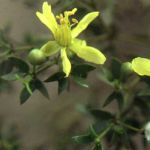| Common Name: |
Grease Bush |
| Other Names: |
Chaparral, grease bush, greasewood, hediondilla |
| Botanical Name: |
Larrea divaricata, Larrea tridentata |
| Genus: |
Larrea |
| Family: |
Zygophyllaceae |
| Native Location: |
Desert areas of Mexico and USA (California, Utah, and Texas) |
| Cultivation: |
Larrea species do not appear to thrive outside their native habitat. |
| Propagation: |
Larrea species do not appear to thrive outside their native habitat. |
| Harvest: |
Young leafy twigs are cut and used fresh for teas and tinctures, or dried for tablets and ointment. The high resin content makes the twigs and foliage difficult to grind. |
| Height: |
2-4m (6-12ft) |
| Width: |
2-4m (6-12ft) |
| Hardiness: |
Z8 |
| Parts Used: |
Leafy twigs. |
| Properties: |
A strongly bitter, resinous, alterative herb that has potent antioxidant, antibiotic, antifungal, and anti-inflammatory, and anti-tumor effects; also antiseptic, especially on the respiratory and urinary systems. |
| Medicinal Uses: |
Internally for kidney and gall stones, urinary tract infections, rheumatism and arthritis, diabetes, skin disorders, cancer (notably leukemia), liver ailments, and tetanus. Externally for wounds, dry skin, brittle hair and nails, arthritic pain, and foot odor.
To treat bronchitis, fever, diabetes, joint pain, and colds; as a "blood purifier" for infections of the genitourinary and respiratory tracts. |
| Typical Dose: |
A typical dose of chaparral may range from 1 to 3 ml of a 1:5 dilution of tincture three times a day. |
| Possible Side Effects: |
Chaparral's side effects include liver damage and, when used externally, contact dermatitis. |
| Drug Interaction: |
| Taking chaparral internally with these drugs may cause or increase liver damage: |
| Abacavir,(Ziagen) |
Acarbose,(Prandase, Precose) |
Acetaminophen,(Genepap, Tylenol) |
Allopurinol,(Aloprim, Zyloprim) |
| Atorvastatin,(Lipitor) |
Celexicob,(Celebrex) |
Cidofovir,(Vistide) |
Cyclosporine,(Neoral, Sandimmune) |
| Docetaxel,(Taxotere) |
Dofetilide,(Tikosyn) |
Erythromycin,(Erythrocin, Staticin) |
Etodolac,(Lodine, Utradol) |
| Fluconazole,(Apo-Fluconazole, Diflucan) |
Fluphenazine,(Modecate, Prolixin) |
Fluvastatin,(Lescol) |
Foscarnet,(Foscavir) |
| Ganciclovir,(Cytovene, Vitrasert) |
Gemfibrozil,(Apo-Gemfibrozil, Lopid) |
Gentamicin,(Alcomicin, Gentacidin) |
Ibuprofen,(Advil, Motrin) |
| Indinavir,(Crixivan) |
Isoniazid,(Isoatamine, Nydrazid) |
Ketoconazole,(Apo-Ketoconazole, Nizoral) |
Ketoprofen,(Orudis, Rhodis) |
| Ketorolac,(Acular, Toradol) |
Lamivudine,(Epivir, Heptovir) |
Levodopa-Carbidopa,(Nu-Levocarb, Sinemet) |
Lovastatin,(Altocor, Mevacor) |
| Meloxicam,(MOBIC, Mobicox) |
Methotrexate,(Rheumatrex, Trexall) |
Methyldopa,(Apo-Methyldopa, Nu-Medopa) |
Morphine Hydrochloride,(Morphine Hydrochloride) |
| Morphine Sulfate,(Kadian, MS Contin) |
Naproxen,(Aleve, Naprosyn) |
Nelfinavir,(Viracept) |
Nevirapine,(Viramune) |
| Nitrofurantoin,(Furadantin, Macrobid) |
Ondansetron,(Zofran) |
Paclitaxel,(Onxol, Taxol) |
Pantoprazole,(Pantoloc, Protonix) |
| Phenytoin,(Dilantin, Phenytek) |
Pioglitazone,(Actos) |
Piroxicam,(Feldene, Nu-Pirox) |
Pravastatin,(Novo-Pravastatin, Pravachol) |
| Prochlorperazine,(Compazine, Compro) |
Propoxyphene,(Darvon, Darvon-N) |
Repaglinide,(GlucoNorm, Prandin) |
Rifampin,(Rifadin, Rimactane) |
| Rifapentine,(Priftin) |
Ritonavir,(Norvir) |
Rofexicob,(Vioxx) |
Rosiglitazone,(Avandia) |
| Saquinavir,(Fortovase, Invirase) |
Simvastatin,(Apo-Simvastatin, Zocor) |
Stavudine,(Zerit) |
Tamoxifen,(Nolvadex, Tamofen) |
| Tramadol,(Ultram) |
Zidovudine,(Novo-AZT, Retrovir) |
|
| Lab Test Alterations: |
May increase results of liver function tests including alkaline phosphatate, apartic acid transaminase (AST,SGOT), alanine amino-transferase (ALT,SGPT), total bilirubin, urine bilirubin, gamma-glutamyltransferase, and lactate dehydrogenase. |
| Disease Interactions: |
May worsen liver disease. |
| Supplement Interactions: |
May increase the risk of liver damage when combined with herbs and supplements that can cause hepatotoxicity (destructive effects on the liver), such as Bishop's Weed, Borage, Uva Ursi, and others. |
| Economic Uses: |
Until synthetic antioxidants were developed, NDGA was important in the food industry for preventing rancidity in fats, oil, dairy products, frozen meats and fish, and in pharmaceutical preparations containing vitamin A and reserpine (from Rauvolfia serpentina, See, rauwolfia). |
| Bibliography: |
Encylopedia of Herbs by Deni Brown Copyright ©: 1995, 2001 Dorling Kindersley Limited pp 251-252
The Essential Herb-Drug-Vitamin Interaction Guide by Geo. T. Grosberg,MD and Barry Fox,PhD. Copyright ©2007 Barry Fox,PhD. Pp. 142-144 |

